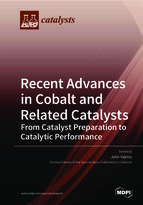Recent Advances in Cobalt and Related Catalysts: From Catalyst Preparation to Catalytic Performance
A special issue of Catalysts (ISSN 2073-4344). This special issue belongs to the section "Catalytic Materials".
Deadline for manuscript submissions: closed (31 October 2020) | Viewed by 26608
Special Issue Editor
Interests: preparation; characterization and testing of supported catalysts; environmental friendly processes; advanced oxidation processes; biochar applications; acid-base behavior of nanoparticles; potentiometric mass titrations; metal support interactions
Special Issues, Collections and Topics in MDPI journals
Special Issue Information
Dear Colleagues,
In our days Cobalt and related catalysts are very attractive because they exhibit a lot of advantages like low cost and high activity in a significant variety of different applications. Cobalt - catalysts are among the most active catalysts for Fischer-Tropsch synthesis and they promote the catalytic activity of the hydrodesulfurization catalysts. Also they found other significant applications in environmental protection like oxidation of volatile organic compounds, VOC, persulfate activator, ammonia synthesis, electrocatalysis and many more. Cobalt -catalysts are active, stable and exhibit significant oxidation - reduction activity, as the Co can be found either as Co(II) or Co(III). Also many molecules can interact with cobalt supported phase by co - ordination due to partially filled d-orbital. Co- catalysts can be supported in almost all the inorganic supports like alumina, titania, zeolites etc. The cobalt oxide phase can be stabilized onto the surface of the support due to variable interactions between support and cobalt phase. These interactions are crucial for catalytic activity and can be regulated by proper selection of the preparation parameters like the type of support, the Co loading, impregnation method and thermal conditions.
This Special Issue aims to cover recent progress and advances in the field of Cobalt and related catalysts. This includes, but is not restricted to, the synthesis of catalysts with different preparation methods, their catalytic performance in different catalytic processes in which the catalyst are active and selective, the effect of preparation method in physicochemical characteristics of supported active phase and the correlation between catalytic activity and their physicochemical characteristics. Finally, new catalytic applications of Co-catalysts and comparison with other similar catalysts are strongly welcoming.
Dr. John Vakros
Guest Editor
Manuscript Submission Information
Manuscripts should be submitted online at www.mdpi.com by registering and logging in to this website. Once you are registered, click here to go to the submission form. Manuscripts can be submitted until the deadline. All submissions that pass pre-check are peer-reviewed. Accepted papers will be published continuously in the journal (as soon as accepted) and will be listed together on the special issue website. Research articles, review articles as well as short communications are invited. For planned papers, a title and short abstract (about 100 words) can be sent to the Editorial Office for announcement on this website.
Submitted manuscripts should not have been published previously, nor be under consideration for publication elsewhere (except conference proceedings papers). All manuscripts are thoroughly refereed through a single-blind peer-review process. A guide for authors and other relevant information for submission of manuscripts is available on the Instructions for Authors page. Catalysts is an international peer-reviewed open access monthly journal published by MDPI.
Please visit the Instructions for Authors page before submitting a manuscript. The Article Processing Charge (APC) for publication in this open access journal is 2700 CHF (Swiss Francs). Submitted papers should be well formatted and use good English. Authors may use MDPI's English editing service prior to publication or during author revisions.
Keywords
- Co–catalysts
- Supported catalysts
- Catalysts preparation,
- Physicochemical properties of supported catalysts
- Catalytic evaluation
- Fischer–Tropsch synthesis






